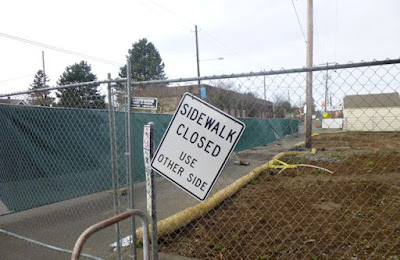Safety made the priority list as the plywood advertisements and silt fencing came off the corners of the fenced job site, allowing drivers and pedestrians to make turns and navigate traffic along Fremont. Thank you to the tenacious folks at the bureau of transportation. Already neighborhood business owners and residents have remarked how much better it feels.
It's possible we don't need the fencing in the parking lane after all. The best idea for a sidewalk closure this far-reaching (only 80 of the 130-plus feet out there is permitted) may be a sheltered walkway running parallel to the curb that would make it easier for both drivers and pedestrians.
Speaking of Fremont, here's an average situation during a recent rush-hour morning, when everyone's going to work and kids are heading toward Beaumont and Alameda schools. Even the crosswalk is congested. Where will 70 additional cars go?
 |
| During morning rush hour, Fremont backs up for two blocks at the 42nd Avenue light. |
Considering the expense and time of LUBA appeals and city dithering, a moratorium might be the cheapest way yet to sort out all the issues.
With all the difficulties in the demolition and project setup of the proposed Beaumont Wilshire project, one wonders how construction will proceed. If the envelope of a building needs so much tweaking (main entrance of Richmond building needs to be moved, per LUBA; Beaumont Wilshire building needs a generous setback), how will the interior go?
Without offering parking, the developer makes public shared space part of his pro forma. Anyone building a house in Portland also has to build in parking; giving developers of these no-parking buildings a free pass doesn't help anybody but their wallets.

No comments:
Post a Comment